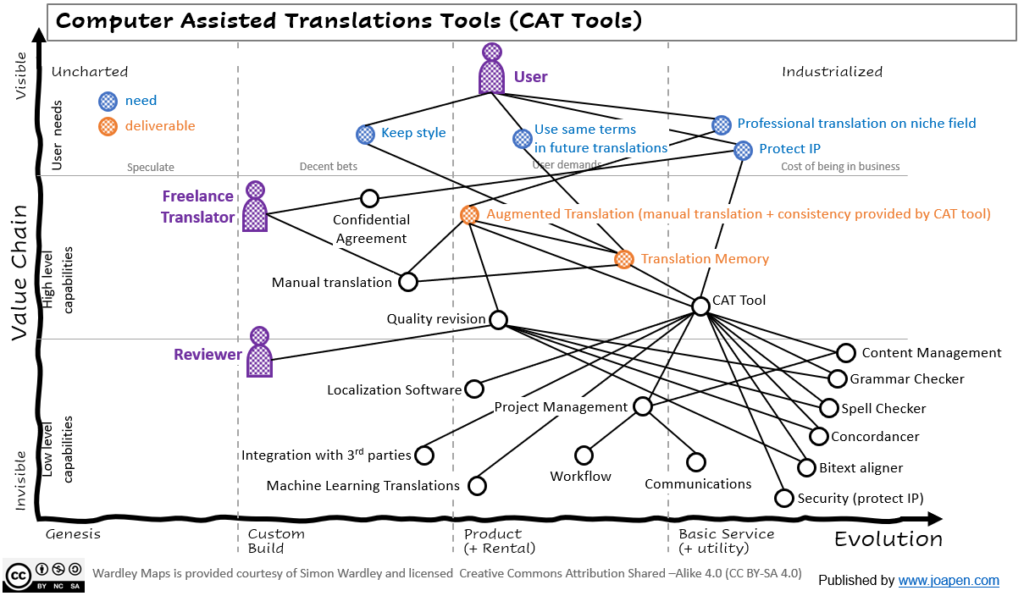Background
Professional translation services have evolved from different angles. Many computer assisted programs enable automatic translations of generic texts, but for specific niche such medicine, pharmacy, scientific papers, or any other field, you need to perform a professional translation in other way.
Manual translation is something unusual, as there are tools that help the “Translator” (typically a freelance) to perform the translation.
Since many years there are platforms where translations services are offered and provided. They have evolved from the manual translation to the computer assisted translation.
This post tries to review the momentum of these platforms, looking at the user needs and how the platform offers these capabilities.
The user and its needs
The user is a company, professional or organization that requires a professional translation of a text.
The basic needs are:
- A translation with high quality, that can be in one language or multiple languages.
- Consistent terminology:
- Ability of keeping the same nomenclature in future translations.
- Keep the style of the original ones.
- This is specially required in legal documents (legal, finance, pharma…)
- Project management: when different languages and content is part of the final outcome, to have some type of management to understand where are the deliverables and how they are progressing is useful for complex projects:
- Coordinate quality checks,
- build a specific workflow,
- enable coordination between members (it’s usual that for multi-language projects different translators are involved).
Concepts of a CAT
Translation Memory
A translation memory is a database that stores sentences, paragraphs or segments of text that have been translated before. These units composed by source and target are known as translation units (TUs).
There are already Translation memories that have years and they continue growing up. Clients provide the source documents to be translated and a TM. The TM with new updates is required as a deliverable of the project.
You will find the name “termbase”, when this database of terms is multilingual. A termbase stores words with translations, descriptions and usage rules.
Reviewers
They are the people performing quality checks between source and target documents. They do not perform all the work, there are automation tools that support the translator and the reviewer.
Checkers
Spell checker and grammar checkers are the more commons ones. If the platform provides it, they are interrelated with the translation memory.
Concordancer is a computer program that automatically constructs a concordance. The output of a concordancer may serve as input to a translation memory, or as an early step in machine translation.
Bitext aligners is a software which aligns a source text and its translation which can then be analyzed using a full-text search tool or a concordancer.
Localization Software
Localization is the process of adapting internationalized software for a specific region or language by translating text and adding locale-specific components.
A Wardley Map about the CAT Services
The CAT tools does not offer always the same, but right now the majority of them provides basic services as: contact with freelancers, checkers’ tools, TMs management, IDE for translators.
Some of them add project management, APIs to enable the integration with third parties, localization services, and other features.

These tools right now offer a great set of capabilities for the people in the translation business.
The major benefits:
- Better quality,
- lower response time,
- lower cost,
- and better consistency.
Talking to a couple of freelance translators, they told me the same: to be competent you have not only to demonstrate you know how to translate, you have to be proficient in some of these platforms. This is the level of competence expected.
CAT Vs Co-Pilot
If you think about a translator and a software developer working with a CAT and co-pilot you can figure out an specialist producing lines of translated texts or code with the assistance of the technology, where the person is driving the work and the software is riding close to the person.
I have heard that right now some of the lines of code returned by co-pilot are not the more efficient when you look at the run time or use of capacities. I have commented this fact to the translators I have talked trying to understand how good or bad it works the CAT tools they use.
Some links
- Community for language professionals: https://www.proz.com/
- Platform for translation services:
- Trados: https://www.trados.com/
- Wordfast: https://www.wordfast.com/
- Memoq: https://www.memoq.com/
